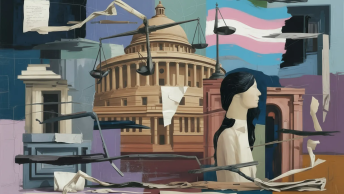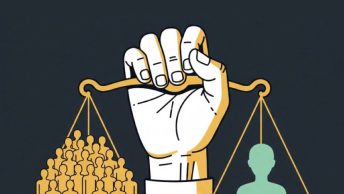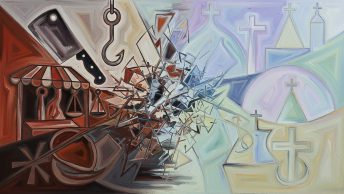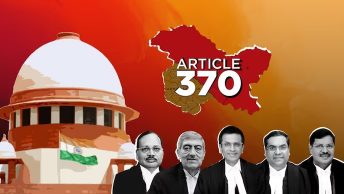The history of the queer movement in India has been a history of continuous contestation, redefinition, and re-evaluation, all leading to the altar of the nation’s apex court. Today marks the culmination of a decades-long battle, fought by an army of invisible, marginalized and abused individuals who have faced immense trials and tribulations while taking on the burden of mobilising the Indian queer voice.
Through this post, we explore the Indian queer movement as both a watershed moment in legal history as well as an emancipatory force in philosophical and social thought, as tied into arguably its most notorious public face – Section 377 of the Indian Penal Code, 1860. While the law itself is a product of its time and reflects Victorian morals of what constitutes chaste sexual activity (seen as the only desirable form of gender and sexual expression), it has since been conflated with exclusively homosexual activities in an attempt to draw attention to the disparity between its colonial antecedents and Indian socio-political history. This co-option by the queer movement has essentially ensured that the very fulcrum of this movement has become solely balanced on this one section. Which begs the question, where does the Indian queer movement go from here?
Tracing the Path of 377
Historically, laws which sought to curb non-heterosexual expression did so by explicitly regulating sexual activity through sodomy laws and entrenched religious practice. In this regard, however, Section 377 has a non-traditional history. The provision in question was modelled on the Buggery Act of 1533, and drafted by Sir Thomas Macaulay. This Act defined ‘buggery’ as an “unnatural sexual act against the will of God and man”, which is perhaps where the link between queer sexual activity and “carnal intercourse against the order of nature” as defined in Section 377 draws its connection from.
The queer movement in India, when contrasted with that in the USA for instance, has turned most of its attention towards the existence and implications of such a link. This has resulted in the loudest, and most persistent, queer demand being simply for the explicit recognition of LGBTQ+ rights as being constitutionally fundamental rights. This base demand has not yet collectively moved on to demanding equal protection, equal opportunity of marriage and civil partnership, or equal right of service, or explicit anti-workplace discrimination as in other jurisdictions for the sole reason that the existence of Section 377 is seen as a barrier to the free expression of queerness. Whether such a barrier is externally imposed or has been self-created often gets lost in the discussion of Section 377 as being merely a targeted penal law. It is clear now, however, that the existence of this barrier rests on the assumption that it is meant exclusively to discriminate on the grounds of gender expression and sexual behaviour, which leaves it ripe to challenges under Arts. 14, 15, 19(1)(a) and 21 of the Constitution.
Transformative Constitutionalism and the Argument for Recognition
It is important to note that the focus on the jurisprudential and constitutional validity of Section 377 only began in the early 2000s. While a petition seeking the removal of Section 377 was filed in 1994 by the AIDS Bhedbhav Virodhi Andolan (ABVA), the idealistic group of petitioners found themselves without much notable support (to the extent that there were only six ‘openly gay men’ in the 1990s). These petitions were finally dismissed in 2001.
Over the past two decades, however, this particular provision has caught the eye of Indian socio-legal academicians due to the possibility of a challenge premised on its disregard for a variety of fundamental rights. The early interest taken by these academicians, coupled with increasing liberalisation, ensured a basis for the general populace to engage with and build the queer movement as we know today. The very fact that there was academic discourse on the topic, which acted as a reference database to the individuals involved in grassroots level of the movement, empowered the movement to move past the paper and onto the pavement.
This trend corresponded to, and perhaps stimulates, the slow but sure change taking place in the wider society. Indeed, one of the biggest and most convincing arguments in favour of explicit recognition of LGBTQ+ rights is the argument against the presumption of continued validity of a pre-constitutional law, which no longer conforms to the moral zeitgeist. This approach to constitutional interpretation is in stark contrast to the narrow and pragmatic approach which has been utilised by the court previously. The claims to transformation that the Indian Constitution often makes can only be justified if other laws, which are subject to the constitution, follow the same line of reasoning.
The Idea of Rights Themselves
One of the most prominent justifications for Section 377 taking such a pivotal role in the Queer Movement is the paradoxical situation such a dormant provision facilitates. It is a well-advertised fact that the number of convictions under this 200+ year law is less than 50 individuals, whilst the arrest rates on the other hand have been growing, exponentially, especially since the Suresh Kumar Koushal judgment. The abovementioned paradox here comes into play when queer individuals are no longer secure of their liberties. The law in itself, based purely on figures, has no significant immediate consequence to individuals, but it is the existence of the law that has the far greater damaging effect.
As evidenced by the previously mentioned figures, the low conviction rates versus the high arrest rates show that this law has become a tool in the hands of the bigoted populace to oppress, suppress and threaten anyone who deviates consciously (sometimes, not even so) from the societal heteronormativity. Section 377, even more so post the 2013 Supreme Court judgment, has become less of a law and more of a sword, constantly and ominously hanging over the necks of queer individuals who are stuck between their desire for expression and the abuse of this Victorian law. It is this very component of Section 377, not the law itself but rather the scope for creating skewed power dynamics of the law, which has made it the largest hurdle for a majority of the Indian Queer movement.
Now, Where Do We Go from Here?
The Indian queer movement might have taken great strides towards acceptance, as opposed to mere tolerance, but it must be recognised that this change has largely been driven by urban, upper class activists who have benefited from the privileges of intersectionality. The movement continues to invisibilise a large variety of queer experiences, particularly in its disconnect with the transgender community’s push for legal recognition. Hope now rests on the effect of this judgment percolating through to the margins of queer life in India, and in helping to revolutionise daily interactions, both public and private, between individuals and institutions.
We must recognise that the decriminalisation of Section 377 is only the first stepping stone on the long road towards ensuring long-term legal recognition of wider social, economic and political rights for the LGBTQ+ community, as well as working towards normalising queer experience as part of everyday social behaviour. While the road ahead may seem long, hard, and riddled with further hurdles, we can only seek to hold our heads high and continue to march forward, towards a society that no longer shames differences but celebrates them.
Priyamvadha Shivaji and Shweta Rao are students at NALSAR University of Law, Hyderabad.








Awesome article!!
Can you be more specific about the content of your article? After reading it, I still have some doubts. Hope you can help me. https://accounts.binance.com/en-IN/register?ref=UM6SMJM3
Your article helped me a lot, is there any more related content? Thanks!
Thank you for your sharing. I am worried that I lack creative ideas. It is your article that makes me full of hope. Thank you. But, I have a question, can you help me?